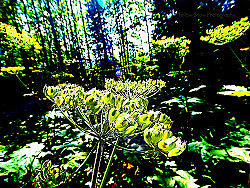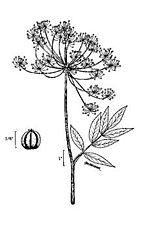Western water hemlock
| Western water hemlock |
|---|

|
| Scientific Classification |
|
| Binomial Name |
|
Cicuta douglasii |
The western water hemlock is a species of water hemlock known by the scientific name cicuta douglasii. Is it also known as the poison hemlock due to its toxicity. Although an exotic plant, it has become naturalized in the Eastern United States.
Anatomy
The leaves of the western water hemlock are alternate, compound, and can divide up to three times. The leaves have petioles the cover a little bit of the stem, and the upper leaves are not dissected. The compound leaves of this plant are about three inches through ten inches long and two inches through six inches wide. The basal leaves of this plant are larger with no petioles then the cauline leaves. The leaflets are pointed at the top and rounded or tapered at the bottom and mostly one through four inches long and one forth through one and one forth inches wide. It is hairy with regular notched edges. The leaflets veins don’t extend into the tip, but instead into the notches the leaves have. The stems all come from a connected base and spreads out word as they go up. This whole plant can get up to about seven feet tall and the base is often striped with a purple color [2]
Reproduction
The western water hemlock relates to a lot of other plants in the area of reproduction. It is perennial so it grows year after year, and its active growth period is spring and summer [3]. There are two seeds per flower and are spread by wind, water, mills, and on clothing. This plant is extremely poisonous to people which could happen through there seeds but is more likely to happen through their roots and stems [4].
Ecology
Stream banks, ditches, meadows, wet pastures, and other wet places like these are some common places were the western water hemlock grows at. A large common place though for it to grow is in British Colombia. In British Colombia you will see it most often in its wetter areas like Okanogan, Mainland, Island, and Caribou. The spotted water hemlock is a similar species and is found a little east of the Coast-Cascade Mountains, and in North America, it is found at the bottom of the Rocky Mountains to the pacific coast. The seed is mostly spread by water and wind, but can sometimes by spread by other ways in machinery [5].
References
- The Wild Classroom 2005-2007
- Weeds Bc weeds BC
- Sage Bud Sage bud, 2011
- Agriculture Government of Saskatchewan, 2008


